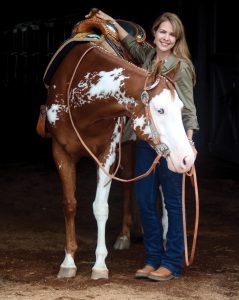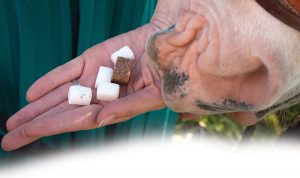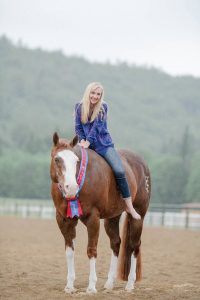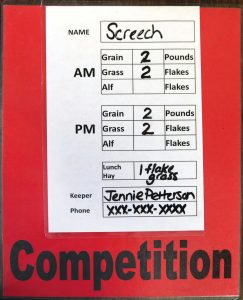paykwik al
online sportwetten
paykasa
 Appaloosa Horse Club (ApHC) Show Manager Keri LeForce, who has been working with ApHC for 27 years, stresses that drug testing has become much more specific in recent years. LeForce says that most positive drug tests come from inaccurate medication dosing. “A lot of times, these situations happen accidentally. For instance, one person gives the horse a dose of an approved medication and then the horse is given another dose from another person in the barn who is unaware that the medication has already been administered,” she explains. To alleviate these miscommunications that can have devastating consequences, LeForce recommends visibly posting medication schedules and marking off when a horse gets a dose of medication.
Appaloosa Horse Club (ApHC) Show Manager Keri LeForce, who has been working with ApHC for 27 years, stresses that drug testing has become much more specific in recent years. LeForce says that most positive drug tests come from inaccurate medication dosing. “A lot of times, these situations happen accidentally. For instance, one person gives the horse a dose of an approved medication and then the horse is given another dose from another person in the barn who is unaware that the medication has already been administered,” she explains. To alleviate these miscommunications that can have devastating consequences, LeForce recommends visibly posting medication schedules and marking off when a horse gets a dose of medication.
 One of the ways to avoid having a positive drug test is by closely regulating diet, supplements, and medication needs before each show. Jennifer Petterson, Professor and Division Chair of Equestrian Studies at William Woods University in Fulton, Missouri, has come up with some helpful strategies to ensure clean drug tests, even with multiple students and visitors coming in and out of their barn of over 150 horses. “In our setting, we’re dealing with multiple breeds and multiple disciplines with many different governing bodies with different rules as far as permitted drugs for competition,” she says. With multiple horses attending USEF, AQHA, APHA, and PtHA shows, there are a lot of different rulebooks to consult to ensure each horse complies with the rules for their respective association. “Since we have students involved with feeding, farrier work, and many visitors coming in and out of the barns, we knew we needed a protocol that was easy to understand. It needed to make it very clear that, when a horse was getting ready to go to a competition, they shouldn’t be given anything that could lead to a positive drug test,” she explains. The system that has since been implemented at William Woods University involves placing a large, laminated, red card that reads “competition” underneath the horse’s regular feed card. “Although it seems simple, the red card means three things: don’t give any medications; don’t sedate for any vet or farrier work; and any sort of treats or supplements not on the feed card must be discussed with the owners before administration,” Petterson explains.
One of the ways to avoid having a positive drug test is by closely regulating diet, supplements, and medication needs before each show. Jennifer Petterson, Professor and Division Chair of Equestrian Studies at William Woods University in Fulton, Missouri, has come up with some helpful strategies to ensure clean drug tests, even with multiple students and visitors coming in and out of their barn of over 150 horses. “In our setting, we’re dealing with multiple breeds and multiple disciplines with many different governing bodies with different rules as far as permitted drugs for competition,” she says. With multiple horses attending USEF, AQHA, APHA, and PtHA shows, there are a lot of different rulebooks to consult to ensure each horse complies with the rules for their respective association. “Since we have students involved with feeding, farrier work, and many visitors coming in and out of the barns, we knew we needed a protocol that was easy to understand. It needed to make it very clear that, when a horse was getting ready to go to a competition, they shouldn’t be given anything that could lead to a positive drug test,” she explains. The system that has since been implemented at William Woods University involves placing a large, laminated, red card that reads “competition” underneath the horse’s regular feed card. “Although it seems simple, the red card means three things: don’t give any medications; don’t sedate for any vet or farrier work; and any sort of treats or supplements not on the feed card must be discussed with the owners before administration,” Petterson explains.
paykwik
online sportwetten
paykasa
Drug Testing – Keeping It Clean
Click here to read the complete article
 By Erica Greathouse
By Erica Greathouse
We all dream of that moment in the spotlight when all of the long nights, early mornings, miles traveled, and hours spent at the barn lead to being the last one standing in the arena. It’s a moment that keeps many of us going when we want to quit. In those tough moments, that dream is enough to push us to work a little bit longer, sleep a little bit less, and continue to put in the hours necessary to achieve victory. We imagine our horse having a neck ribbon fastened tight and the feeling of taking a victory lap in front of a cheering crowd.
But can you imagine all of that being taken away in the blink of an eye? It has happened in the past, and will likely happen in the future, but you certainly don’t want to be at the receiving end of a phone call letting you know that your horse has received a positive drug test.
Whether intentional or unintentional–because it does happen–a positive drug test is something we’d never wish upon anyone. However, drug testing is a necessary part of competition in order to protect the welfare of our equine athletes and to ensure a level playing field for exhibitors. As a result, passing a drug test is an instrumental part of securing a title at most major, and some regional, events. In most classes, the champion, and many times a random entry, are selected for drug testing. Drug testing by accredited laboratories is fundamental to ensuring the safety of our horses and the integrity of our horse shows. In order to make sure that these big moments aren’t clouded by a positive drug test, it’s important to know the drug rules of the governing body or association in charge of the show where you’re competing. It’s also very important to be aware of the ingredients of all medications, supplements, treats, and food that your horse ingests.

Drug testing can take place at an event at the discretion of the governing association and show management. According to APHA Member Care Specialist Jennifer Crites, who has been with APHA for the past 25 years, the job of drug testers is to maintain a level playing field for all exhibitors. “At the World Show, class champions, as well as placings selected at random, are tested. At the World Show, our drug testing collectors are at the exit gate to greet and congratulate the exhibitor and inform them that their horse will be drug tested. At that time, the exhibitor and horse are escorted to the drug-testing stall for collection of blood or urine. The horse is supervised by both the testing collector and the exhibitor, owner, trainer, or authorized party in order to ensure the proper chain of custody of the horse and sample,” Crites explains. To make the collection process most efficient for all parties, Crites suggests that the exhibitor, trainer, owner, and/or authorized third-party cooperate with the requests of the testing collector. “We often recommend using the designated drug-testing stalls for testing purposes, rather than the horse’s personal stall, since it’s already free from distractions and often encourages the process to go more quickly. If, for some reason, the drug testing cannot be completed immediately, the exhibitor, owner, and/or authorized third party must stay with the animal at all times until testing is complete,” she says.
In some instances, blood draws by an official licensed testing veterinarian can help to expedite the testing process.
 Appaloosa Horse Club (ApHC) Show Manager Keri LeForce, who has been working with ApHC for 27 years, stresses that drug testing has become much more specific in recent years. LeForce says that most positive drug tests come from inaccurate medication dosing. “A lot of times, these situations happen accidentally. For instance, one person gives the horse a dose of an approved medication and then the horse is given another dose from another person in the barn who is unaware that the medication has already been administered,” she explains. To alleviate these miscommunications that can have devastating consequences, LeForce recommends visibly posting medication schedules and marking off when a horse gets a dose of medication.
Appaloosa Horse Club (ApHC) Show Manager Keri LeForce, who has been working with ApHC for 27 years, stresses that drug testing has become much more specific in recent years. LeForce says that most positive drug tests come from inaccurate medication dosing. “A lot of times, these situations happen accidentally. For instance, one person gives the horse a dose of an approved medication and then the horse is given another dose from another person in the barn who is unaware that the medication has already been administered,” she explains. To alleviate these miscommunications that can have devastating consequences, LeForce recommends visibly posting medication schedules and marking off when a horse gets a dose of medication.Another thing to keep in mind is how medications are administered. “Giving horses medication in their feed can make it hard to regulate the timing of the dose and can sometimes lead to an overage on a drug test,” she says. “Unfortunately, even if the overage was a mistake, intent is not taken into account, and an overdose is an overdose. It’s important to make sure you know what’s going on with your horse and that there is ample communication about the administration of medication.”
LeForce recommends being very cautious when it comes to medication schedules. “Once it’s too late, there is nothing that can be done. If a medication needs to be given a certain number of hours out, it’s important to realize that class schedules aren’t always concrete,” she explains. Proper planning and the knowledge that all horses metabolize medications at different rates is important, however, it’s crucial to remember that permitted doses are merely guidelines set in place to help prevent overages, but aren’t necessarily a one-size-fits-all guarantee.
Following a successful performance, the natural response is a celebration. Many times, that happens in the form of treats for our beloved equine companions. In a recent Equine Chronicle poll, our readers shared some of their horse’s favorite snacks with us. Some non-traditional horse treats include: beer, soda, rigatoni, Sour Patch Kids, Skittles, grapes, bananas, Red Vine candy, tuna sandwiches, peppermints, pita chips, Fritos, cereal, watermelon, Pop-Tarts, oranges, French fries, sugar cubes, butterscotch candies, Goldfish crackers, and donuts. This list is not exhaustive by any means, and it’s clear that we love to share human food with our horses. However, the consensus from this poll was that, despite the lengthy ingredient lists on many of these snacks, few exhibitors have ever considered the fact that some of the ingredients could lead to a positive drug test.

Longtime APHA exhibitor and multiple World Champion Megan Blye of Corona, California, loved to spoil her favorite geldings, KatchMyBlaze and Real Me In, for their championship performances in the show arena. “I’ve always been one to spoil my horses rotten with standard treats like apples and carrots. However, the World Show was always special. Whenever my horses did well in a class, I would give them a bag of Sour Patch Kids. They would practically mow me down when they heard the bag crinkle in my pocket, and I always thought that knowing that a bag awaited them after a good performance motivated them to give a little extra out in the arena. Thankfully, we never had a positive drug test, but I never thought about checking the ingredients or making sure that the amount I was giving them was okay,” Megan says.
Another veteran to World Show competition is Mackenzie Preston who showed her gelding, Brokers Lucky Kid, to multiple World titles. Preston was taught early on to be careful when giving treats to her beloved gelding who would eat just about everything. “We knew to be careful with treats and drug testing. We were always told not to give him Cheetos, which were his favorite treat, because the red dye could show up on a drug test. There were still plenty of other treats that he would eat including beer, tuna sandwiches, and any type of cookie or cracker. There was nothing he would turn down, but we were always careful at horse shows. We would still spoil him when he won, but we would make sure to steer clear of artificial red dyes,” she explains. Although neither Blye nor Preston had a positive drug test due to the treats they fed their geldings, they both acknowledge that it’s better to be safe than sorry.
Although each breed association has different variations of drug regulations, the majority follows the Association of Racing Commissioners International (ARCI) guidelines. The ARCI is the umbrella organization that’s responsible for rulemaking for professional horse and greyhound racing. For 85 years, the ARCI has set international standards for medication policies, as well as drug testing laboratories, and their standards are relied upon worldwide. The ARCI classifies drugs in five categories based on their pharmacology, drug use patterns, and appropriateness of drug use. Some drugs are prohibited altogether, and others are allowed in permissible doses. Those connected with each horse must ensure that the animal complies with the rules. LeForce suggests reading the ingredient list on everything that a horse might ingest to make sure there are no ingredients that could cause a positive drug test. “Just because a package says it’s safe doesn’t mean that it will not test. Make sure to do your research and ask questions ahead of time for clarification,” she advises.
Crites agrees that knowledge is power. “Although APHA cannot make any recommendations, we would encourage the owner to seek advice from their veterinarian and know the ingredients in the products they choose to use, how those ingredients are classified on the ARCI list, and how they might be treated in terms of the APHA Rule Book,” she says. Furthermore, knowing the drug rules for each specific association is key in order to avoid any negative implications.
 One of the ways to avoid having a positive drug test is by closely regulating diet, supplements, and medication needs before each show. Jennifer Petterson, Professor and Division Chair of Equestrian Studies at William Woods University in Fulton, Missouri, has come up with some helpful strategies to ensure clean drug tests, even with multiple students and visitors coming in and out of their barn of over 150 horses. “In our setting, we’re dealing with multiple breeds and multiple disciplines with many different governing bodies with different rules as far as permitted drugs for competition,” she says. With multiple horses attending USEF, AQHA, APHA, and PtHA shows, there are a lot of different rulebooks to consult to ensure each horse complies with the rules for their respective association. “Since we have students involved with feeding, farrier work, and many visitors coming in and out of the barns, we knew we needed a protocol that was easy to understand. It needed to make it very clear that, when a horse was getting ready to go to a competition, they shouldn’t be given anything that could lead to a positive drug test,” she explains. The system that has since been implemented at William Woods University involves placing a large, laminated, red card that reads “competition” underneath the horse’s regular feed card. “Although it seems simple, the red card means three things: don’t give any medications; don’t sedate for any vet or farrier work; and any sort of treats or supplements not on the feed card must be discussed with the owners before administration,” Petterson explains.
One of the ways to avoid having a positive drug test is by closely regulating diet, supplements, and medication needs before each show. Jennifer Petterson, Professor and Division Chair of Equestrian Studies at William Woods University in Fulton, Missouri, has come up with some helpful strategies to ensure clean drug tests, even with multiple students and visitors coming in and out of their barn of over 150 horses. “In our setting, we’re dealing with multiple breeds and multiple disciplines with many different governing bodies with different rules as far as permitted drugs for competition,” she says. With multiple horses attending USEF, AQHA, APHA, and PtHA shows, there are a lot of different rulebooks to consult to ensure each horse complies with the rules for their respective association. “Since we have students involved with feeding, farrier work, and many visitors coming in and out of the barns, we knew we needed a protocol that was easy to understand. It needed to make it very clear that, when a horse was getting ready to go to a competition, they shouldn’t be given anything that could lead to a positive drug test,” she explains. The system that has since been implemented at William Woods University involves placing a large, laminated, red card that reads “competition” underneath the horse’s regular feed card. “Although it seems simple, the red card means three things: don’t give any medications; don’t sedate for any vet or farrier work; and any sort of treats or supplements not on the feed card must be discussed with the owners before administration,” Petterson explains.This protocol is extremely strict and even prohibits carrots, apples, peppermints, or any other treat that students and visitors may bring into the barn. Additionally, Petterson stresses the importance of calling to check on the legality of any questionable medications and substances. “We’re always calling and never take any risks on unknown substances, even if they seem like they would be okay. USEF is very strict, and even peppermints can test in large volumes!” she says. Petterson points out that she has learned that some of the ingredients in common treats aren’t problems in their own right; however, they can be masking agents for illegal substances and, therefore, aren’t permissible.

She says, “Another thing we’re very aware of are treats that have supplements in them. For example, some treats claim to have calming effects, and some treats are supposedly healthy for joints. Often, these types of treats have substances in them that aren’t legal; but, because they’re packaged as a horse treat, people forget to think about ingredients in the cookies that might not be allowed.” Petterson places the competition cards on horses’ stalls that are slated to compete two weeks before the horse show to ensure that they’re not taking any chances when it comes to drug testing. “Two weeks is probably overkill, but we don’t want to take any chances. We love our horses, and we want to spoil them with treats, but we make sure to do it with caution,” she says.
The moral of the story is that knowledge is power regarding drug testing. Knowing the specific rule for each competition is the responsibility of every exhibitor, trainer, and owner. A positive drug test always leads to a negative outcome, and nothing ruins a dream like having a title taken away after it has already been given. “Although drug violation punishments are decided according to the class of drug, a positive drug test means that the title will be pulled, no matter what. It’s so important to be aware of the approved doses for each medication and check to make sure nothing fed to your horse could yield a positive drug test,” LeForce says.










